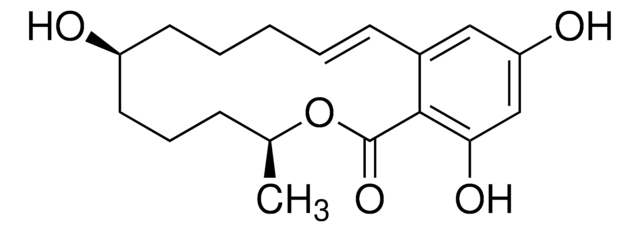CRM16869
Diquat metabolite Monopyridone
certified reference material, TraceCERT®, Manufactured by: Sigma-Aldrich Production GmbH, Switzerland
Sinónimos:
1-Oxo-9,10-dihydro-1H-10a-aza-8a-azoniaphenanthrene chloride, 6,7-Dihydro-9-oxo-9H-dipyrido[1,2-a:2′,1′-c]pyrazin-5-ium chloride
About This Item
Productos recomendados
grado
certified reference material
TraceCERT®
Nivel de calidad
Línea del producto
TraceCERT®
caducidad
limited shelf life, expiry date on the label
fabricante / nombre comercial
Manufactured by: Sigma-Aldrich Production GmbH, Switzerland
Formato
neat
temp. de almacenamiento
2-8°C
cadena SMILES
O=C1N2CC[N+]3=CC=CC=C3C2=CC=C1.[Cl-]
InChI
1S/C12H11N2O.ClH/c15-12-6-3-5-11-10-4-1-2-7-13(10)8-9-14(11)12;/h1-7H,8-9H2;1H/q+1;/p-1
Clave InChI
FYUAZDQCXQJCPZ-UHFFFAOYSA-M
¿Está buscando productos similares? Visita Guía de comparación de productos
Categorías relacionadas
Descripción general
Certified content by quantitative NMR incl. uncertainty and expiry date are given on the certificate.
Download your certificate at: http://www.sigma-aldrich.com
Diquat monopyridone is a common degradation product of Diquat. Diquat is a nonselective, defoliant, preharvest, and desiccant herbicide that belongs to the bipyridinium class. Diquat can rapidly penetrate through the leaf surface but is not taken up by the roots, due to its strong adsorption onto the soil particles. Its activity is based on the liberation of the superoxide anion radical, followed by hydrogen peroxide, causing tissue destruction by oxidative stress. The herbicidal activity of diquat is more pronounced in daylight, aerobic conditions, high humidity, and temperature.
Diquat is not approved for its use in the European Union. The maximum residue limit (MRL) for diquat presence in the crops varies between 0.05 mg/kg in most of the commodities to 10 mg/kg for linseed and barley.
The EU residue definitions are broader, however, the toxicological data is still missing for the diquat metabolites, monopyridone and dipyridone, to compare their toxicity with the parent compound.
Aplicación
- Detection of two diquat metabolites in urine and serum of poisoned patients after ingestion of combined herbicides, paraquat and diquat
- Analysis of paraquat, diquat, and two diquat metabolites in biological materials by high-performance liquid chromatography coupled with UV and fluorescence detectors
Información legal
Palabra de señalización
Danger
Frases de peligro
Consejos de prudencia
Clasificaciones de peligro
Acute Tox. 2 Inhalation - Acute Tox. 3 Dermal - Acute Tox. 3 Oral - Aquatic Acute 1 - Aquatic Chronic 1 - Eye Irrit. 2 - Skin Irrit. 2 - Skin Sens. 1 - STOT RE 1 Oral - STOT SE 3
Órganos de actuación
Respiratory system
Código de clase de almacenamiento
6.1A - Combustible acute toxic Cat. 1 and 2 / very toxic hazardous materials
Clase de riesgo para el agua (WGK)
WGK 2
Punto de inflamabilidad (°F)
Not applicable
Punto de inflamabilidad (°C)
Not applicable
Elija entre una de las versiones más recientes:
Certificados de análisis (COA)
It looks like we've run into a problem, but you can still download Certificates of Analysis from our Documentos section.
Si necesita más asistencia, póngase en contacto con Atención al cliente
¿Ya tiene este producto?
Encuentre la documentación para los productos que ha comprado recientemente en la Biblioteca de documentos.
Nuestro equipo de científicos tiene experiencia en todas las áreas de investigación: Ciencias de la vida, Ciencia de los materiales, Síntesis química, Cromatografía, Analítica y muchas otras.
Póngase en contacto con el Servicio técnico
![[Des-Tyr22]-Calcitonin salmon](/deepweb/assets/sigmaaldrich/product/images/282/634/15345f68-95be-4b5f-abc2-cb170099f26f/640/15345f68-95be-4b5f-abc2-cb170099f26f.jpg)





